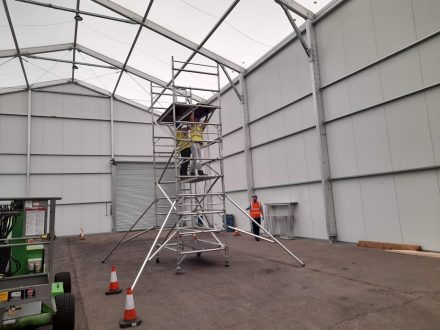Essential Scaffold Safety
Every year people are hurt falling from scaffolding because simple rules and procedures haven’t been followed correctly – whether it’s a dangerous or incorrect erection method, resulting in an unsafe structure, or the structure being misused which can cause slips, trips, falls, and even overturned towers!
Scaffold safety is not just about following the rules and avoiding HSE fines or legal penalties, it’s essential to maintain high standards and to keep your workers, and the general public, safe.
The best way to gain a thorough understanding of the governing regulations, ensuring your company is operating within the law and not risking the health or safety of your workers or the public, is to ensure your scaffolding team undergo a PASMA accredited tower scaffolding course.
These courses are approved by the HSE, so you can rest assured they cover all the necessary subjects…
Erection and dismantling
There are two safe methods of work that should be followed when constructing tower scaffolding-
The Advanced Guard Rail System is where temporary guard rail units are fitted to the working platform from below, ensuring they are safely in place before any workers access the platform.
The ‘Through the Trap’ Method is where the operative fits the guard rails from a trap door in the platform, so as to ensure they don’t access an unguarded platform.
Stability
Stability is assured by guaranteeing certain procedures and rules are adhered to-
- Firstly, the tower must be positioned on firm, level ground and the base plates must be properly secured.
- Secondly, stabilisers or outriggers must be fitted in line with the manufacturers’ directions (instruction manual).
- Lastly, it is essential that the tower is never erected to a height bigger than directed by the manufacturer.
Precautions and Inspection
Tower scaffolds should be constructed to the same standards as all scaffolds, with double guardrails, toe-boards, bracing and access ladders.
This is essential as without all the necessary parts in the correct position, the structure will not have adequate strength, which could easily lead to a collapse.
If a worker could fall more than 2 meters from the platform, the scaffold must be inspected directly after erection and then at least every 7 days. If any faults are found, all work must cease until they have been fixed.
All inspections should be documented and recorded.
Using and Moving
Using
It’s essential you don’t use scaffold towers if there’s a chance it could become unsafe, for example never use towers:
- In severe weather or strong winds
- To provide support for access equipment
- If parts are broken or missing
- With incorrect or incompatible components
Moving
It’s vital that you follow some simple rules when moving a tower, making sure you always:
- Ensure the tower is no higher than 4 meters
- Inspect the area for power cables or overhead obstructions
- Make sure the ground is firm and flat
- Manually push or pull, from the base
And never move a tower with people, equipment or materials still on it!
Tower scaffolding is the best way to keep you workers safe while they are working at a height and by following simply rules, and keeping your workers up to date with training, you can be sure you’ll be doing everything possible to keep your site a safe place.
For more information about PASMA scaffolding safety courses, from an approved instructor contact the professional team at Health and Safety Training Ltd.
Increase Your Employability With Health And Safety Training The Hazards of Working at Heights





